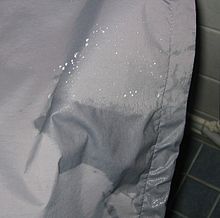Fluoropolymers
Fluoropolymers or fluoroplastics are polymers based on fluorocarbons with multiple carbon-fluorine bonds, in which mostly a large part or even all of the other hydrogens contained are replaced by fluorine (see per- and polyfluorinated alkyl compounds ).
Fluoropolymers are characterized, among other things, by their high chemical and temperature resistance. They are elastic to tough, but usually not very strong . Just like the fluorocarbons , they are not affected by the Van der Waals force , like hydrocarbons , and therefore have anti-stick and friction-reducing properties. The multiple carbon-fluorine bonds give them great chemical resistance.
With a market share of 60–70%, polytetrafluoroethylene (PTFE), which is sold under the trade name Teflon , has the greatest economic importance . Other important fluoropolymers are tetrafluoroethylene-hexafluoropropylene copolymer (FEP) and polychlorotrifluoroethylene (PCTFE). Thermoplastic fluoropolymers make up 30% of fluoropolymers. The higher the fluorine content, the better the temperature and chemical resistance. The polytetrafluoroethene (PTFE) discovered in 1938 is still unsurpassed.
General
Fluoropolymers are divided into those that cannot be processed in the melt (English Non-Melt Processible Fluoroplastics , e.g. PTFE), those that can be processed in the melt ( thermoplastic fluoropolymers or fluorothermoplastics ; English Melt Processible Fluoroplastics ), Fluorinated rubbers ( FKM or FPM ) and other fluoroelastomers ( perfluorinated rubber FFKM , tetrafluoroethylene / propylene rubbers FEPM , fluorinated silicone rubbers ).
Fluoropolymers often consist exclusively of carbon atoms in the main chain, but there are also those with heteroatoms, e.g. B. polyfluorosiloxanes and polyfluoroalkoxyphosphazenes.
properties
Polytetrafluoroethylene (PTFE) is the most important fluoropolymer in terms of quantity. From it the properties of other fluoropolymers can be derived as PTFE as a regular body functions for most other fluoropolymers.
Chemical properties
The mechanical properties of a material are based on its chemical properties. Despite the large electronegativity difference between carbon and fluorine, polytetrafluoroethylene is a non-polar polymer, since the spatially opposite dipoles cancel each other out. The chemical properties are determined by the strong carbon- fluorine bond, which is difficult to break. The unbranched molecular chain with a very high degree of polymerisation (strong linearity ) leads to high crystallinity . The molecular structure of PTFE is completely symmetrical; Since the fluorine atoms (in relation to the hydrogen in polyethene ) are relatively large, they shield the carbon structure and force the molecular chain into a helix structure .
Mechanical properties
In general, if the polarity is low, strength , rigidity , hardness and thermal expansion are low, while the insulation capacity is high. This is also the case with PTFE. The high degree of crystal extrusion results in a high softening temperature , an extremely high viscosity of the melt and high resistance to heat and chemicals. The low intermolecular forces also result in low strength and rigidity as well as low surface adhesion.
Properties of thermoplastic fluoropolymers
The processing of PTFE is difficult. Due to the high viscosity of the melt, PTFE cannot be processed in a softened state like other thermoplastics. Thermoplastic processability can be achieved by modifying the monomer tetrafluoroethene . Fluorine atoms are replaced by chlorine (as in polychlorotrifluoroethylene ) or a trifluoromethyl (as in tetrafluoroethylene-hexafluoropropylene copolymer ), which leads to disturbances in the regular molecular structure. The chemical and heat resistance of the thermoplastically processable polymers are reduced by the modification.
Use and processing

Fluoropolymers have a high chemical and thermal stability, good electrical insulating properties, excellent weather resistance, good notched impact strength , anti-adhesive behavior and they are incombustible. The anti-adhesive properties result in poor wettability and good sliding properties . Fluoropolymers are physiologically harmless. The modulus of elasticity and tensile strength of thermoplastic fluoropolymers correspond to those of standard plastics.
Fluoropolymers are counted among the high-performance plastics. The disadvantage of fluoropolymers is their high cost and difficult processing.
PTFE
Of all materials, PTFE has the greatest chemical resistance. It is high temperature resistant, incombustible and a good electrical insulator. PTFE can be used in the range from −270 to +280 ° C. PTFE does not melt above the operating temperature, it only softens. Decomposition takes place above 400 ° C. PTFE is a thermoplastic, but due to its very high melt viscosity, it cannot be processed using the processing methods commonly used for thermoplastics, such as injection molding . Components and semi-finished products made of PTFE can therefore only be manufactured using the press- sintering process . It is white, flexible and very slippery. Due to its resistance, PTFE is used in laboratory environments, for high temperature insulation and in high voltage technology. Foamed PTFE has a microporous structure, is water-repellent and air-permeable. Stretched PTFE with micropores is used under the name Gore-Tex as a waterproof, but vapor-permeable layer in textiles. PTFE tends to creep under load; however, this can be counteracted with fillers. Because PTFE is very non-polar, it is anti-adhesive and has excellent sliding properties. Thanks to the strong carbon-fluorine bond, it is also very weather and UV-resistant.
Since PTFE is very viscous above the high melting temperature , it cannot be processed with conventional primary molding processes. PTFE is therefore processed either in the form of pastes or powders by pressing and sintering as well as a combination of both. Machining is avoided due to the high material costs.
Thermoplastic fluoropolymers
In addition to the two fluoropolymers shown here, tetrafluoroethylene-hexafluoropropylene copolymer (FEP) and polychlorotrifluoroethylene (PCTFE), there are numerous other thermoplastic fluoropolymers. However, these polymers are not as durable as PTFE; PCTFE is attacked by chlorinated hydrocarbons and esters, FEP by chlorinated hydrocarbons. The thermoplastics can be processed using common methods such as extrusion and injection molding . These polymers are prepared and used in the same way as PTFE.
Economical meaning
Today's world demand for fluoropolymers is around 100,000 tons per year (2004). Fluoropolymers are very expensive at 10–35 € / kg compared to standard plastics , due to their complex production. Fluorine production is based on the mineral fluorspar , which is sufficiently available worldwide. Important areas of application can be found in the construction of chemical plants and apparatus, in mechanical engineering and in electrical engineering .
Examples
| polymer | Trade name | Monomer (s) | Melting point (° C) |
|---|---|---|---|
| Polyvinyl fluoride (PVF) | Tedlar (DuPont) | Vinyl fluoride | 200 |
| Polyvinylidene fluoride (PVDF) | Kynar (Arkema) Solef (Solvay Solexis) Hylar (Solvay Solexis) | Vinylidene fluoride | 175 |
| Polytetrafluoroethylene (PTFE) | Teflon (DuPont), Algoflon and Polymist (Solvay Solexis), Polyflon ( Daikin ) | Tetrafluoroethylene | 327 |
| Polychlorotrifluoroethylene (PCTFE) | Kel-F ( 3M ), Neoflon ( Daikin ) | Chlorotrifluoroethene | 220 |
| Perfluoroalkoxy Polymers (PFA) | Neoflon ( Daikin ) | z. B. PPVE + TFE | 305 |
| Ethylene tetrafluoroethylene (ETFE) | Tefzel (DuPont), Fluon Asahi Glass Company , Neoflon ( Daikin ) | Tetrafluoroethylene + ethylene | 265 |
| Perfluoro (ethylene propylene) (FEP) | Symalit FEP | Tetrafluoroethylene + hexafluoropropylene | 257 |
Biological importance
Fluoropolymers show no acute or subchronic systemic toxicity, irritation, sensitization, local toxicity in implants , genotoxicity ( in vitro and in vivo ), hemolysis , complement activation or thrombogenicity . This distinguishes them from other representatives of per- and polyfluorinated alkyl compounds (PFAS).
Monomers used as the basis of fluoropolymers
- Perfluoro cycloalkenes (PFCA)
- Ethene (E)
- Fluoroethene (VF1)
- 1,1-difluoroethene (VDF or VF2)
- Tetrafluoroethylene (TFE)
- Chlorotrifluoroethylene (CTFE)
- Propylene (P)
- Hexafluoropropylene (HFP)
- Perfluoropropyl vinyl ether (PPVE)
- Perfluoromethyl vinyl ether (PMVE)
Individual evidence
- ^ Robert E. Putnam: Polymerization of Fluoro Monomers . In: Comprehensive Polymer Science and Supplements . tape 3 , p. 321-326 , doi : 10.1016 / B978-0-08-096701-1.00085-9 .
- ↑ a b c d e f g h i j Wolfgang Kaiser : Plastic chemistry for engineers: From synthesis to application . 2nd Edition. Carl Hanser, 2007, ISBN 978-3-446-41325-2 , pp. 65, 386–395 ( 386–395 # v = onepage limited preview in Google Book Search).
- ↑ a b c d e f Wilhelm Keim: plastics: synthesis, manufacturing processes, apparatus . 1st edition. Wiley-VCH, Weinheim 2006, ISBN 3-527-31582-9 , pp. 1 ( limited preview in Google Book search).
- ↑ Sina Ebnesajjad: Non-Melt Processible Fluoroplastics . Elsevier, Norwich, NY 2000, ISBN 1-884207-84-7 , pp. 33 .
- ↑ Sina Ebnesajjad: Melt processible Fluoroplastics . Elsevier, Norwich, NY 2002, ISBN 1-884207-96-0 , pp. 23 .
- ↑ Entry on fluoropolymers. In: Römpp Online . Georg Thieme Verlag, accessed on June 14, 2014.
- ↑ Thermoplastic fluoroplastics , Polytron plastics technology
- ↑ Hans-Georg Elias: Makromoleküle, Volume 4: Applications of polymers . 6th edition. Wiley-VCH, Weinheim 2003, ISBN 3-527-29962-9 , pp. 325 ( limited preview in Google Book Search).
- ↑ Andreas Kalweit, Christof Paul, Sascha Peters and others: Handbook for Technical Product Design . 2nd Edition. Springer, Berlin 2012, ISBN 978-3-642-02641-6 , pp. 102 ( limited preview in Google Book search).
- ↑ a b Christopher C. Ibeh: THERMOPLASTIC MATERIALS Properties, Manufacturing Methods, and Applications . CRC Press, 2011, ISBN 978-1-4200-9383-4 , pp. 491-497 .
- ^ Reichelt Chemietechnik GmbH & Co. KG - www.rct-online.de
- ↑ Sina Ebnesajjad, Pradip R. Khaladkar: Fluoropolymers Applications in Chemical Processing Industries , PDL - Plastics Design Library, ISBN 0-8155-1502-2 .
- ↑ Barbara J Henry, Joseph P Carlin, Jon A Hammerschmidt, Robert C Buck, L William Buxton, Heidelore Fiedler, Jennifer Seed, Oscar Hernandez: A critical review of the application of polymer of low concern and regulatory criteria to fluoropolymers . In: Integrated Environmental Assessment and Management . tape 14 , no. 3 , 2018, p. 316-334 , doi : 10.1002 / ieam.4035 .



